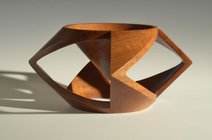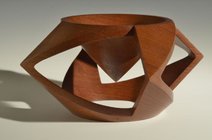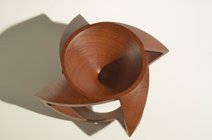If I want to use edge glued 3/4” kiln dried S4S boards to turn a platter, what do think about using a glue block and a screw chuck to secure the piece to the lathe? I am considering a 12” finished platter.
-
December 2025 Turning Challenge: Single Tree! (click here for details) -
Congratulations to Bob Henrickson, People's Choice in the November 2025 Turning Challenge (click here for details) -
Congratulations to Dave Roberts for "Low Rider" being selected as Turning of the Week for December 1, 2025 (click here for details) -
Welcome new registering member. Your username must be your real First and Last name (for example: John Doe). "Screen names" and "handles" are not allowed and your registration will be deleted if you don't use your real name. Also, do not use all caps nor all lower case.
You are using an out of date browser. It may not display this or other websites correctly.
You should upgrade or use an alternative browser.
You should upgrade or use an alternative browser.
Glue Block Use
- Thread starter Lewis Elliott
- Start date
Depends on how thick your blank is. Screw chucks can be used on thinner blanks if you use a spacer so you don't have to drill too deep. I would want at least 1/2 inch into the blank, and a wide set of jaws. How are you going to mount the blank when you reverse it? Another glue block? Recess? Tenon? For me, I use a big forstner bit to drill a recess in the top side of any blank I turn, expand the chuck into that, turn the bottom, turn a shallow recess (less than 1/8 inch), reverse, and turn the inside.
robo hippy
robo hippy
Good points, a second glue block could make balance an issue when I reverse the turning to do the top. I need to think through an approach a little more. Thanks for the sanity check.Depends on how thick your blank is. Screw chucks can be used on thinner blanks if you use a spacer so you don't have to drill too deep. I would want at least 1/2 inch into the blank, and a wide set of jaws. How are you going to mount the blank when you reverse it? Another glue block? Recess? Tenon? For me, I use a big forstner bit to drill a recess in the top side of any blank I turn, expand the chuck into that, turn the bottom, turn a shallow recess (less than 1/8 inch), reverse, and turn the inside.
robo hippy
- Joined
- Feb 28, 2021
- Messages
- 1,764
- Likes
- 1,577
- Location
- Roulette, PA
- Website
- www.reallyruralwoodworks.com
I've done edge glued bowls and platters no problem (basically make cutting boards and then glue the boards together to build up thickness for a bowl, etc - always just turned them with a tenon, if you plan your platter right, you can just edge glue your 12 x 12 stock then glue on a 3 x 3 (or so) "board" on the "bottom" face and turn a tenon with that for a scroll chuck, mounted between centers , or just glue up your screw chuck waste block right onto the middle of your platter stock (with it being thick enough you can also part off the waste block after it is turned) .
One of my latest projects is learning glue blocks and all the various holding techniques, especially for my shallow/valuable blanks. To control for variables as much as possible for the strongest hold, in your ideal world what wood and grain orientation would you glue block users consider ideal? I've used a few woods randomly just because I had about the right size blank to use it as such, with varying degrees of success. Straight-grained solid maple would seem to be ideal, but I'd like to hear from experts. Thanks in advance!
Great input , thanks I appreciate it.I've done edge glued bowls and platters no problem (basically make cutting boards and then glue the boards together to build up thickness for a bowl, etc - always just turned them with a tenon, if you plan your platter right, you can just edge glue your 12 x 12 stock then glue on a 3 x 3 (or so) "board" on the "bottom" face and turn a tenon with that for a scroll chuck, mounted between centers , or just glue up your screw chuck waste block right onto the middle of your platter stock (with it being thick enough you can also part off the waste block after it is turned) .
- Joined
- Apr 27, 2004
- Messages
- 9,301
- Likes
- 6,056
- Location
- Lakeland, Florida
- Website
- www.hockenberywoodturning.com
If I want to use edge glued 3/4” kiln dried S4S boards to turn a platter, what do think about using a glue block and a screw chuck to secure the piece to the lathe? I am considering a 12” finished platter.
Lyle Jamieson has nice video on glue blocks.
I’ve been using his method since he showed it to me in 2000.
Two tips to concentrate on.
1. Make the mating surfaces concave. Dead flat is nearly impossible concave is easy on the lathe
Concave lets the glue go toward the center making a wide glue line
2. Give the glue block a slight twist as it contacts the the work piece. This ensures spreads nicely.
Last edited:
Thanks hockenbery. Good information, l’ll review the video.Lyle Jamieson has nice video on glue blocks.
I’ve been using his method since he showed it to me in 2000.
Two tips to concentrate on.
1. Make the mating surfaces concave. Dead flat is nearly impossible concave is easy on the lathe
Concave lets the glue go toward the center making a wide glue line
2. Give the glue block a slight twist as it contacts the the work piece. This ensures spreads nicely.
View: https://youtu.be/y8b35iq4LTA
Not sure you're hearing from an expert, but I use a piece of big box store poplar to make a glue block. Titebond with an overnight cure. Long grain of work piece parallel to long grain of glue block. When done, the poplar glue block is easy to cut off with a parting tool.One of my latest projects is learning glue blocks and all the various holding techniques, especially for my shallow/valuable blanks. To control for variables as much as possible for the strongest hold, in your ideal world what wood and grain orientation would you glue block users consider ideal? I've used a few woods randomly just because I had about the right size blank to use it as such, with varying degrees of success. Straight-grained solid maple would seem to be ideal, but I'd like to hear from experts. Thanks in advance!
I glue a sheet of sandpaper to scrap plywood. I mount a 6" faceplate to the TS. Then with the workpiece or glue block mounted to the HS, I place the sanding board between the workpiece and faceplate, and snug up the faceplate sandwiching the sanding board against the workpiece (the 6" diameter faceplate gives enough reference surface). I turn the HS spindle manually. The sanding board can be repositioned to expose fresh grit.Make the mating surfaces concave. Dead flat is nearly impossible concave is easy on the lathe
Concave lets the glue go toward the center making a wide glue line
If that was not clear, I may have a picture somewhere.
- Joined
- Apr 27, 2004
- Messages
- 9,301
- Likes
- 6,056
- Location
- Lakeland, Florida
- Website
- www.hockenberywoodturning.com
That should come real close to dead flat until the wood moves if it so chooses.glue a sheet of sandpaper to scrap plywood. I mount a 6" faceplate to the TS. Then with the workpiece or glue block mounted to the HS, I place the sanding board between the workpiece and faceplate, and snug up the faceplate sandwiching the sanding board against the workpiece (the 6" diameter faceplate gives enough reference surface). I turn the HS spindle manually. The sanding board can be repositioned to expose fresh grit.
Still a trade off.
I think concave is superior to dead flat in addition to speed.
Slight Concave surfaces spread the glue better and also assists in centering better.
How long would it take you turn a slight concave
I’ve used Lyle Jamieson’s methods since learning them 5-6 yrs ago, they always work well. The advantage of ca glue is time and the block separates easily with a chisel vs parting off. Lightly redress the glue side and its ready for the next one. Wood glue paper joint works about the same but you have to wait for it to dry
- Joined
- Feb 28, 2021
- Messages
- 1,764
- Likes
- 1,577
- Location
- Roulette, PA
- Website
- www.reallyruralwoodworks.com
I prefer hot melt glue for glue blocks - lets me position my blank exactly where I want it on a glue block I already have a perfect tenon on, then I just hot glue it to the block (and as Hockenberry prefers my blocks get a slight concave - less than .005" or so) once project is ready to come off glue block, just a cheap HF acid brush dipped in isopropyl alcohol and wait a few seconds, project peels right off with ease..
I didn't know about the alcohol trick. I had a thin wood egg hot-melt glued into homemade cup drive and I had a hell of a time getting it out again. I didn't think I had used that much glue, but it really had a firm grip.I prefer hot melt glue for glue blocks - lets me position my blank exactly where I want it on a glue block I already have a perfect tenon on, then I just hot glue it to the block (and as Hockenberry prefers my blocks get a slight concave - less than .005" or so) once project is ready to come off glue block, just a cheap HF acid brush dipped in isopropyl alcohol and wait a few seconds, project peels right off with ease..
- Joined
- Feb 28, 2021
- Messages
- 1,764
- Likes
- 1,577
- Location
- Roulette, PA
- Website
- www.reallyruralwoodworks.com
Oh yeah - Not just alcohol but you'd have it fall apart on you if you tried to spray on lacquer or other common spray finishes like that.. solvent almost immediately loosens the grip .. so I suppose I should add that as a word of advice, not to try and spray on a finish while it is still on the glue block or it'll go flying off if the lathe is spinning... or at least fall off and land in piles of dust/chips... Funnily enough hot melt glue has an awful strong grip on wood otherwise (I've had nasty catches and the glue bond never let go)
A picture would help a lot.Not sure you're hearing from an expert, but I use a piece of big box store poplar to make a glue block. Titebond with an overnight cure. Long grain of work piece parallel to long grain of glue block. When done, the poplar glue block is easy to cut off with a parting tool.
I glue a sheet of sandpaper to scrap plywood. I mount a 6" faceplate to the TS. Then with the workpiece or glue block mounted to the HS, I place the sanding board between the workpiece and faceplate, and snug up the faceplate sandwiching the sanding board against the workpiece (the 6" diameter faceplate gives enough reference surface). I turn the HS spindle manually. The sanding board can be repositioned to expose fresh grit.
If that was not clear, I may have a picture somewhere.
You caught me at the right moment. Let's see what I have...A picture would help a lot.
et voila:
Set up for sanding the workpiece bottom flat. Spindle rotation is manual-no motor. The face plat is not attached to the sanding board. Note the block underneath can be be varied and the board shifted fore and aft to reposition the sanding board and use more of the abrasive surface.
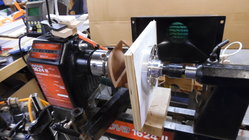
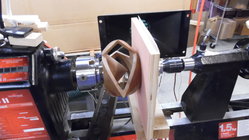
And a photo of the glue block being flattened (on a second chuck):
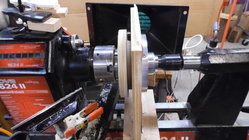
And for extra credit, here is the piece being glued to the sacrificial glue block.
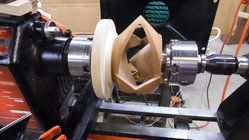
(I consider the live center with chuck adapter to be a critical accessory).
Pictures were nice but immediately made me forget about glue blocks. I want to know about that piece your turning. What is it? How did you turn it?
I have never made an edge glued platter. I have made some thin pieces and I have always made a tenon from scrap wood and glued it onto the piece I am going to turn. Then I can grab it with a Chuck.
Great idea, Rusty-Such a simple solution, and no doubt better than a glue block! I'll try this next time.I have never made an edge glued platter. I have made some thin pieces and I have always made a tenon from scrap wood and glued it onto the piece I am going to turn. Then I can grab it with a Chuck.
Tom Gall
TOTW Team
????? What am I missing? That IS a glue block!Great idea, Rusty-Such a simple solution, and no doubt better than a glue block! I'll try this next time.
He was thinking of something to screw a faceplate onto before.????? What am I missing? That IS a glue block!

